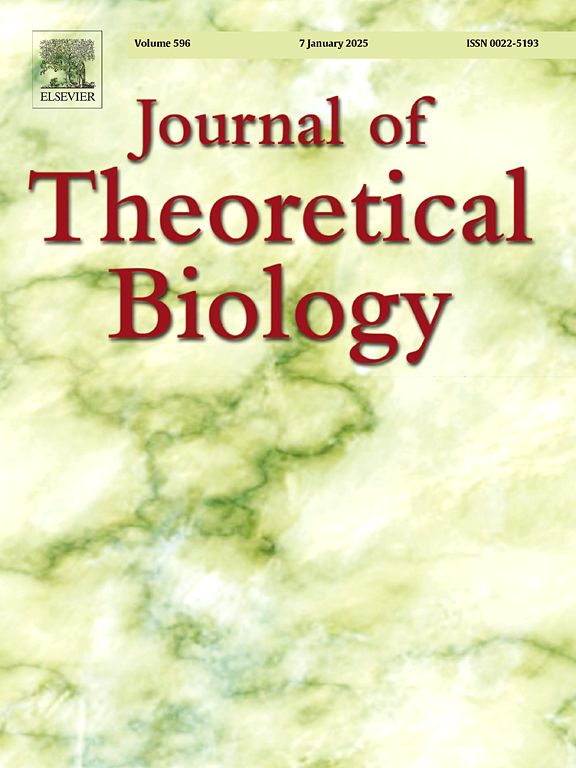量化种内性状变异和种间性状相关性对相互作用种群的影响——非线性平均方法。
IF 2
4区 数学
Q2 BIOLOGY
引用次数: 0
摘要
两个物种之间的相互作用,例如捕食者和猎物之间的相互作用,通常可以被描述为许多个体间相互作用的总和,其结果取决于相互作用个体的特征。这些特征通常在每个物种的个体之间存在很大差异,并且个体并不总是随机相互作用,例如,由于对异质景观中共同环境因素的塑性反应。本文采用非线性平均方法研究了种内性状变异(ITV)和种间性状相关性对物种相互作用的影响。在过去的模型的基础上,我们开发了一个建模框架,允许对任意物种的相互作用进行建模,并将种间性状相关性作为一个新特征。基于两个关键成分,联合性状分布和二维相互作用函数,平均相互作用参数(如平均捕食率)可以量化数值,使用深刻的泰勒近似近似,并与没有独立的情况进行比较。我们重点介绍框架的两个应用程序。首先,我们在一个简单的捕食者-猎物模型中研究了ITV和性状相关性的定量和定性效应,并表明即使在没有进化的情况下,相互作用个体之间的变异和性状相关性也可以促成或破坏物种之间的共存。其次,我们使用捕食者-猎物系统的模拟野外数据来展示如何从经验数据估计ITV对生态相互作用的影响。本文章由计算机程序翻译,如有差异,请以英文原文为准。
Quantifying the effects of intraspecific trait variation and interspecific trait correlations on interacting populations—A nonlinear averaging approach
Interactions between two species, e.g. between a predator species and a prey species, can often be described as the sum of many individual-by-individual interactions whose outcomes depend on the traits of the interacting individuals. These traits often vary substantially among individuals in each species, and individuals do not always interact randomly, e.g. due to plastic responses to a shared environmental factor in a heterogeneous landscape. Here we investigate the impact of intraspecific trait variation (ITV) and such interspecific trait correlations on species interactions via nonlinear averaging. Building on past models that integrate over an interaction kernel to obtain the impacts of ITV, we develop a theoretical framework allowing the modeling of arbitrary species interactions, with interspecific trait correlations as a novel feature. Based on two key ingredients, a joint trait distribution and a two-dimensional interaction function, the average interaction parameters (e.g. average predation rate) can be quantified numerically, approximated using an insightful Taylor approximation, and compared to cases without ITV. We highlight two applications of our framework. First, we study the quantitative and qualitative effects of ITV and trait correlations in a simple predator-prey model and show that even in the absence of evolution, variation and trait correlations among interacting individuals can make or break the coexistence between species. Second, we use simulated field data for a predator-prey system to show how the impact of ITV on an ecological interaction can be estimated from empirical data.
求助全文
通过发布文献求助,成功后即可免费获取论文全文。
去求助
来源期刊
CiteScore
4.20
自引率
5.00%
发文量
218
审稿时长
51 days
期刊介绍:
The Journal of Theoretical Biology is the leading forum for theoretical perspectives that give insight into biological processes. It covers a very wide range of topics and is of interest to biologists in many areas of research, including:
• Brain and Neuroscience
• Cancer Growth and Treatment
• Cell Biology
• Developmental Biology
• Ecology
• Evolution
• Immunology,
• Infectious and non-infectious Diseases,
• Mathematical, Computational, Biophysical and Statistical Modeling
• Microbiology, Molecular Biology, and Biochemistry
• Networks and Complex Systems
• Physiology
• Pharmacodynamics
• Animal Behavior and Game Theory
Acceptable papers are those that bear significant importance on the biology per se being presented, and not on the mathematical analysis. Papers that include some data or experimental material bearing on theory will be considered, including those that contain comparative study, statistical data analysis, mathematical proof, computer simulations, experiments, field observations, or even philosophical arguments, which are all methods to support or reject theoretical ideas. However, there should be a concerted effort to make papers intelligible to biologists in the chosen field.

 求助内容:
求助内容: 应助结果提醒方式:
应助结果提醒方式:


